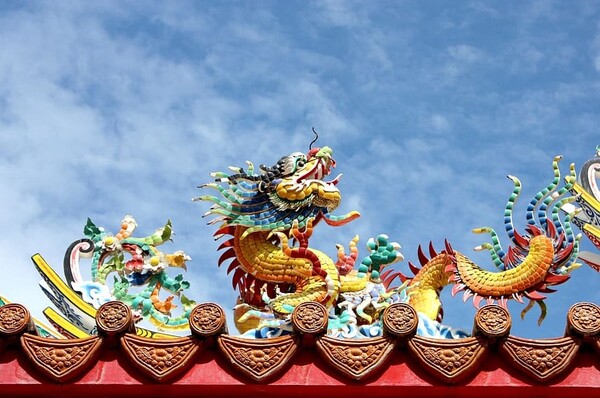
(function(d, s, id) { var js, fjs = d.getElementsByTagName(s)[0]; if (d.getElementById(id)) return; js = d.createElement(s); js.id = id; js.src = “https://connect.facebook.net/en_US/sdk.js#xfbml=1&version=v3.0”; fjs.parentNode.insertBefore(js, fjs); }(document, ‘script’, ‘facebook-jssdk’)); –>
–>
November 4, 2023
Iranian foreign minister Javad Zarif and Chinese foreign minister Wang Yi signed a 25-year strategic cooperation agreement in 2021. China now has its strongest ever economic foothold in Iran. Iranian Foreign Ministry spokesman Saeed Khatibzadeh said the agreement provides a “deep, multilayered and fully fledged” pact to enhance trade, economic and transport cooperation that will be “very effective in deepening” relations with China. University of Tehran professor Mohammad Marandi, who is close to the Iranian regime, said, “This strategic partnership is important because it allows Iran and China to build a roadmap for long-term relations that will be much more fruitful. It’s also a signal being sent to the United States. The more the U.S. tries to isolate Iran and China, the more it causes countries like Iran and China to move more closely to each other.” China views Iran’s economic situation as an opportunity to capitalize on Iran’s limited bargaining power with the West.
‘); googletag.cmd.push(function () { googletag.display(‘div-gpt-ad-1609268089992-0’); }); document.write(”); googletag.cmd.push(function() { googletag.pubads().addEventListener(‘slotRenderEnded’, function(event) { if (event.slot.getSlotElementId() == “div-hre-Americanthinker—New-3028”) { googletag.display(“div-hre-Americanthinker—New-3028”); } }); }); }
In an effort to revive the Iranian nuclear Joint Comprehensive Plan of Action (JCPOA) talks, Enrique Mora, European Union deputy foreign policy chief, traveled to Tehran in May 2022. However, ties with China enacted before Mora’s visit indicated that Iran was preparing a backup option: China. An Iranian diplomat said, “From a general point of view, it is worth remembering that in Tehran the ‘Look to the East’ option has always been considered by Khamenei’s circle in the ‘Daftar-e-Rahberi’ [the Office of Iran’s supreme leader] as a realistic alternative, though not the favorite one, when it comes to establishing viable and sustainable economic and political relationship with other strong economic realities.”
Iran’s ruling clergy has increasingly turned to China for economic, political, and technological support. In April 2022, Chinese defense minister General Wei Fenghe met in Tehran with Iranian army chief Major General Mohammad Bagheri. Both agreed to increase military cooperation. They discussed strategic, defense, and security relations. Wei said his visit was “important against the backdrop of the current turbulent international situation and shows the importance of China-Iran relations.” Wei offered, when he met with Iranian oresident Ebrahim Raisi, to “make good use of cooperation mechanisms, push forward pragmatic cooperation and bring military ties to a higher level.”
Iran wished to acquire Chinese weapons and equipment. According to Sina Azodi, non-resident fellow at the Atlantic Council in Washington, D.C., “Iran is also very interested in expanding its military cooperation and acquiring Chinese military equipment, especially fighter aircrafts. So there is a good chance that those issues were discussed too.”
‘); googletag.cmd.push(function () { googletag.display(‘div-gpt-ad-1609270365559-0’); }); document.write(”); googletag.cmd.push(function() { googletag.pubads().addEventListener(‘slotRenderEnded’, function(event) { if (event.slot.getSlotElementId() == “div-hre-Americanthinker—New-3035”) { googletag.display(“div-hre-Americanthinker—New-3035”); } }); }); }
There may, however, be trouble brewing. The 25-year strategic cooperation agreement has caused discussion among Iranians about the effects of stronger ties with China. Inexpensive Chinese exports have, for over a decade, flooded Iran, undercut Iranian manufacturers’ and artisans’ profits, and put them out of business. Many Iranians say the agreement has “sold Iran to China.” China is using cheap consumer goods to obtain Iranian oil. Iran provides China with large quantities of greatly discounted oil (a commodity upon which Biden won’t enforce sanctions). Most Iranians, hard hit by the results of sanctions, inflation, and economic mismanagement, as well as the trade agreements with China, are forced to purchase the cheaper Chinese goods. As a result, many Iranians have developed a hatred for China and a sense of betrayal by their own leaders.
China is also undercutting prices of goods manufactured in the West. For example, consider the Chinese Geely Automobile Company. The French-made Renault Mėgane, until recently a favorite of many middle-class Iranian car buyers, has had its price triple since 2011. It now sells for about $23,700. The Geely Emgrand EC7 has a slightly lower price at $23,600, which suggests that Zhejiang Geely Holding Group is vying for a larger segment of the Iranian auto market.
Iran’s leaders say Chinese investments are a great opportunity for both nations. However, the vast majority of Chinese companies rely upon Chinese labor and raw materials. Thus, China, not Iran, profits.
Ironically, China enslaves millions of Muslim Uyghurs in more than 1,000 camps in the Xinjiang region in an attempt to wipe out their culture, language, and beliefs. Tiandy, a Chinese company linked to repression of Uyghurs, sells its goods to Iran’s government, military, and intelligence agencies.
Here’s where it gets interesting for Iran.
The 25-year agreement also brings China’s Belt and Road Initiative (BRI), a massive and controversial Pan-Eurasian infrastructure project, to Iran. BRI is an ambitious undertaking to boost China’s connectivity and trade around the world by using its money and expertise in infrastructure development. BRI, launched in 2013, has supplied hundreds of billions of dollars to build bridges, ports, highways, power plants, and telecommunications projects throughout the Middle East, Asia, Latin America, Africa, and eastern Europe. BRI is a symbol of China’s rise as a global power.
‘); googletag.cmd.push(function () { googletag.display(‘div-gpt-ad-1609268078422-0’); }); document.write(”); googletag.cmd.push(function() { googletag.pubads().addEventListener(‘slotRenderEnded’, function(event) { if (event.slot.getSlotElementId() == “div-hre-Americanthinker—New-3027”) { googletag.display(“div-hre-Americanthinker—New-3027”); } }); }); } if (publir_show_ads) { document.write(“
It has, however, piled crippling debt on developing countries, a practice known as “debt trap diplomacy,” which allows China to seize property or assets when debt service can’t be met. It has so far saddled 165 countries with $385 billion owed to China. To illustrate how debt traps work in practice, observe what BRI debt did to Sri Lanka, only twenty miles from India. Its southern Hambantota Port became a strategic Chinese naval asset after a Chinese lender took control of the port on a 99-year lease after Sri Lanka defaulted on its BRI loans.
Scott Morris, a senior fellow at the Center for Global Development, said that China is happy to swap loan debt for rights, ownership, and influence when the prospect of financial repayment becomes bleak.
BRI has become global. As of April 2023, 148 countries have signed memorandums of understanding, have joined (very interesting map here) China’s economic scheme. Twenty-six low-income countries and thirty-nine lower-middle-income countries have joined, just under half of all BRI participants. Forty-one upper-middle-income countries and thirty-three high-income countries constitute over half of the BRI participants. Members include U.S. allies. BRI also works with 18 E.U. countries and 9 G20 countries. So China won’t miss Iran if Iran somehow avoids BRI’s consequences.
Here’s China-Iran’s connection to Hamas. Palestine, which is not an independent country, has also signed. Now China, Iran’s largest trading partner, wants to be on both sides of the conflict. It didn’t condemn Iranian funder Hamas or declare that Israel has a right to self-defense. It wants to play peacemaker. Yi discussed the war during a recent visit to Washington, D.C., pledging to have Beijing use its relationship with Iran to prevent the conflict from spreading. Why? Philip Andrews-Speed, a specialist in China’s oil policies, said, “[China] is highly exposed to the current instability in the Middle East, especially if it escalates.” China is calling for a ceasefire in the Israel-Hamas war because it depends on stable energy markets to fuel its economy.
Of course the bumbling idiot who occupies the Bully Pulpit threw U.S. weight behind China.

Image via Pxfuel.
<!–
–>
<!– if(page_width_onload <= 479) { document.write("
“); googletag.cmd.push(function() { googletag.display(‘div-gpt-ad-1345489840937-4’); }); } –> If you experience technical problems, please write to [email protected]
FOLLOW US ON
<!–
–>
<!– _qoptions={ qacct:”p-9bKF-NgTuSFM6″ }; ![]() –> <!—-> <!– var addthis_share = { email_template: “new_template” } –>
–> <!—-> <!– var addthis_share = { email_template: “new_template” } –>





